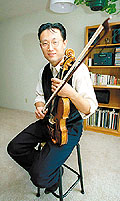By Gregory Shepherd
Advertiser Classical Music Critic
It says a lot when an orchestra’s management has enough confidence in its musicians that soloists are occasionally chosen from the ranks. That confidence is well-placed in this week’s Honolulu Symphony program featuring concertmaster Ignace Jang.
 |
| Concertmaster Ignace Jang artfully plays two complementary pieces in this week’s Honolulu Symphony program.
Advertiser library photo • 1998 |
Ernest Chausson’s "Poeme" and Maurice Ravel’s "Tzigane" showcase two quite different but complementary aspects of Jang’s artistry on the violin. As the title suggests, "Poeme" explores a lyric idiom, which Jang handled at Sunday’s concert with sensitivity, especially the wistful, evocative solo passage that opens the piece. His only real misstep in the work came with an insubstantial tone on the high notes of the closing material. Chausson’s orchestral textures are of pastel transparence, and Samuel Wong’s sense of ensemble brought out its nuances with subtlety.
"Tzigane" ("Gypsy") takes a more raucous turn with one technical challenge
after another testing the outer limits of a performer’s abilities, and here again Jang largely rose to the challenge. His bravura opening surged with confidence, while most of the difficulties of the later passages evaporated, with the exception of a somewhat awkward and inexact pizzicato section. This was more than compensated for by artful work on harmonic passages, and Jang had the audience in his hand by the time he capered nimbly through the final measures. Harpist Constance Uejio proved an able collaborator in both works.
|
‘Beethoven’s Sixth and Ignace Jang’
 The Honolulu Symphony with Samuel Wong conducting The Honolulu Symphony with Samuel Wong conducting
 7:30 p.m. tonight, Neal Blaisdell Concert Hall 7:30 p.m. tonight, Neal Blaisdell Concert Hall
 $15-$55 $15-$55
 792-2000 (Symphony), 526-4400 (Ticket Plus) 792-2000 (Symphony), 526-4400 (Ticket Plus)
|
Beethoven’s Symphony No. 6 is a treasure trove of sublime detail, and Wong’s direction of the orchestra brought out some of it. The first movement opened with a cheerful but somehow sedate mood that didn’t really build into the soaring freedom that some ears have come to expect. There was an unexpected restraint about the movement that seemed out of place, like a hiker reluctant to get his feet muddy.
The second movement interplay between the higher and lower strings swayed gently like willows in the breeze, but the ragged coordination of strings and winds detracted from the mood of serenity. Moreover, there were details in the third movement that were buried, such as the wind section’s response to the string statement of the Allegro portion. The trumpets then went on to overpower the strings.
The impeccable closing section of the finale reminded the listener both of the majesty of Beethoven and of the capabilities of the Honolulu Symphony when they are at their best.
Gregory Shepherd has been The Advertiser’s classical music critic since 1987.
[back to top] |

 The Great Index to Fun
The Great Index to Fun